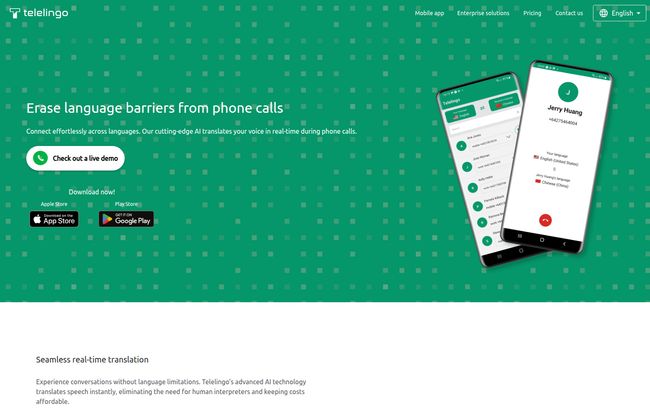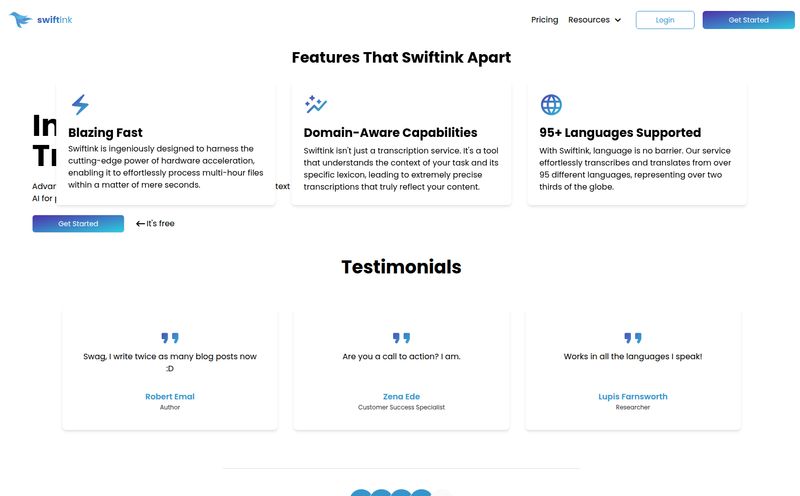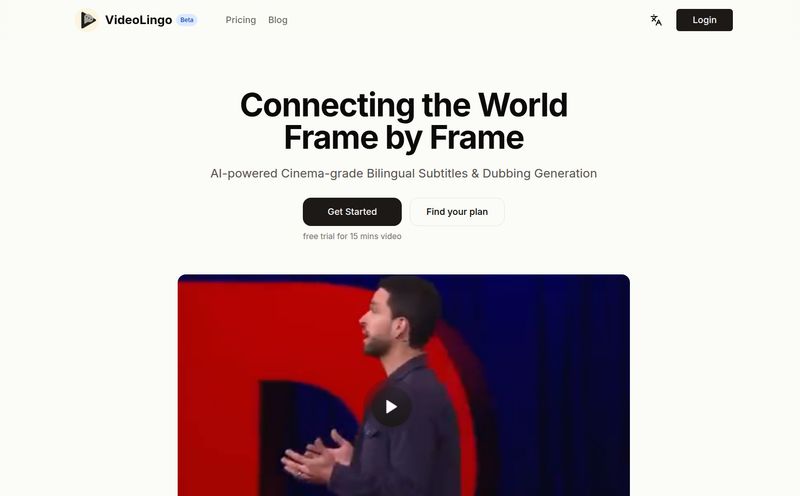I still have mild flashbacks to a time I tried booking a small, family-run guesthouse in the French countryside. My high school French was… let’s just say, très rouillé (very rusty). The conversation involved a lot of desperate gesturing (useless on a phone), slow shouting, and me eventually just spelling out my email address hoping for the best. It was painful. For both of us, I imagine.
We’ve all been there, right? That moment the phone feels less like a communication device and more like a useless brick because the person on the other end speaks a different language. For years, the solution was either a pricey human interpreter or a clunky, multi-step process with different apps. It was a mess.
So when I stumbled upon Telelingo, my inner SEO-nerd and tech-lover lit up. The promise? AI-powered, real-time phone call translation. Like having a tiny, multilingual diplomat living in your phone. It sounded too good to be true. Naturally, I had to dig in.
So What Exactly Is Telelingo?
In simple terms, Telelingo is an AI that translates your voice during a live phone call. You speak in your language, and the person on the other end hears it in theirs, and vice-versa. It’s not a text-to-speech bot you have to type into; it integrates directly with your phone call, using your own SIM card to dial out. It supports over 80 languages, including a bunch of dialects, which is pretty impressive stuff.
Think of it less like Google Translate (which is great for text and short phrases) and more like the Babel Fish from The Hitchhiker's Guide to the Galaxy. It’s meant to create a seamless conversation, erasing that awkward pause-translate-speak cycle. This is for actual, real-time chats on the fly, whether you're calling a mobile number or a landline across the globe.

Visit Telelingo
Breaking Down How It Actually Works
From what I gather, the tech is fairly sophisticated. You initiate the call through the Telelingo app, but it uses your phone's native calling function. The AI sits in the middle, listening to both sides of the conversation, translating, and piping the audio to the respective listener. The goal is to make it feel like a natural, albeit slightly delayed, conversation.
The website shows a little demo of the mobile app in action, and it looks slick. It’s a bold claim, because voice nuance, speed, and local slang are the final bosses of translation AI. But the fact that they're tackling it head-on is exciting.
Who Is This Really For?
I see two main groups of people who would get a ton of value from this. They're quite different, but the core problem is the same.
The Globetrotter and Expat
This is the use case that immediately springs to mind. You're traveling in Japan and need to make a dinner reservation. Or you’ve moved to Spain and need to call the plumber about a leak. Or you're trying to track down a lost package with a courier service in Germany. For these one-off, high-stakes, or just plain convenient calls, having a tool like this would be a lifesaver. It turns a potentially stressful situation into a manageable one.
The Small Business and Enterprise Crew
This is where things get really interesting from a traffic and conversion perspective. Telelingo offers custom enterprise solutions. Think about a medical clinic needing to confirm an appointment with a patient who speaks a different language. Or a law firm conducting a preliminary client intake. Or a financial advisor clarifying details with an international client.
For businesses, they offer a dedicated Telelingo phone number with a fixed price per minute, which removes the guesswork. This is a huge step up from hiring expensive interpretation services for every single call, especially for smaller, day-to-day interactions. It's about efficiency and accessibility.
Let's Talk About the Price Tag
Okay, the big question. How much does this future-is-now technology cost? Their pricing model is refreshingly straightforward, which I appreciate.
It's broken into two main tiers:
- Mobile App: This is a pay-as-you-go plan. It starts from $0.21 per minute. There are no subscriptions or hidden fees, you just top up your account and use the minutes. Now, the catch: the final price-per-minute varies depending on the country you're calling, and they round partial minutes up to the next full minute. That rounding thing is a classic telco move, a bit annoying, but not a deal-breaker.
- Enterprise: This one is a custom plan. You contact them, and they set you up with a dedicated phone number. The beauty here is that you get a fixed price per minute, no matter where you're calling from. This is ideal for businesses that need predictable costs.
Honestly, compared to the cost of a human interpreter, which can run anywhere from $1 to $5 a minute (or more!), the pricing is very competitive for what it offers.
The Good, The Bad, and The AI-Translated
No tool is perfect. After poking around and analyzing the offering, here’s my honest take.
What I'm Excited About
The sheer convenience is off the charts. The idea of seamlessly calling anyone, anywhere, without a language barrier is the stuff of sci-fi. For businesses, it opens up markets and improves customer service. For individuals, it removes a massive layer of travel stress. The pay-as-you-go model for the mobile app is also a huge plus – you're not locked into a monthly fee for a tool you might only use a few times a year.
A Few Things to Keep in Mind
The variable pricing for the mobile app means you'll want to check the rate before making a long call. That rounding-up-the-minute policy could also add up if you make a lot of very short calls. And as with any AI, there will be limitations. It's probably not going to be perfect for highly sensitive, nuanced legal negotiations—at least not yet. But for 90% of everyday conversations? It seems more than capable.
Some might argue that relying on AI erodes the incentive to learn languages. I get that. But I see this more as a practical tool for immediate needs, not a replacement for human connection and learning. It's a bridge, not a destination.
My Final Take: Is Telelingo a Game Changer?
Look, I've been in the SEO and digital trends space for a long time. I've seen countless apps that promise to “revolutionize” communication. Most of them are just noise. Telelingo feels different. It's solving a very real, very old problem with modern tech in a practical way.
Is it perfect? Probaly not. But is it a massive step in the right direction? Absolutely. For frequent travelers, expats, and international businesses, this could easily become an indispensable tool. It’s making the world feel just a little bit smaller, one phone call at a time.
Frequently Asked Questions
- How does Telelingo handle different accents and dialects?
- The platform supports over 80 languages, including many common dialects. The AI is trained on diverse datasets to recognize a variety of accents, but its effectiveness can vary based on the clarity of the speaker and the specific dialect.
- Can I use Telelingo to call a landline?
- Yes, absolutely. The service allows you to call both mobile numbers and landlines worldwide directly from the app.
- Is there a monthly subscription fee?
- For the mobile app, no. It operates on a transparent pay-as-you-go system. You only pay for the minutes you use. The Enterprise plan is custom and may have a different structure based on business needs.
- Does the app work without an internet connection?
- No. Because it relies on powerful AI processing for real-time translation, Telelingo requires a stable internet connection (Wi-Fi or mobile data) to function during your call.
- Is the translation instant?
- It's near real-time. There's a very slight delay as the AI processes, translates, and relays the audio. The goal is to keep this delay minimal to allow for a natural-feeling conversation flow.
- What about privacy and my conversations?
- This is a crucial question for any communication tool. While their specific policy should be reviewed on their site, industry-standard practice for services like this involves secure, encrypted connections. It's always a good idea to check the privacy policy of any app you use for sensitive conversations.
Conclusion
In a world that’s more connected than ever, language remains one of the last true barriers. Tools like Telelingo aren't just novelties; they are practical solutions to a fundamental human challenge. It's not about replacing the richness of learning a new language, but about enabling communication when and where you need it most. And for that, it gets a solid nod of approval from me.



